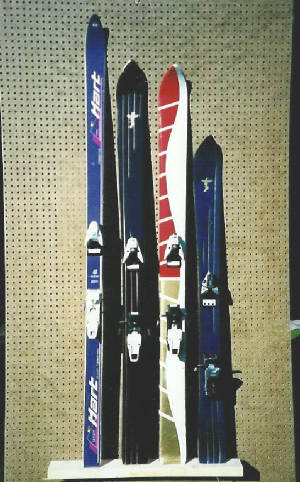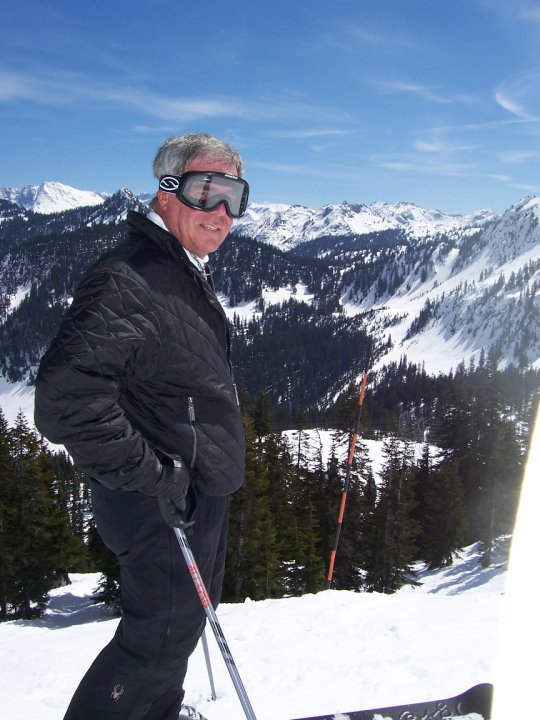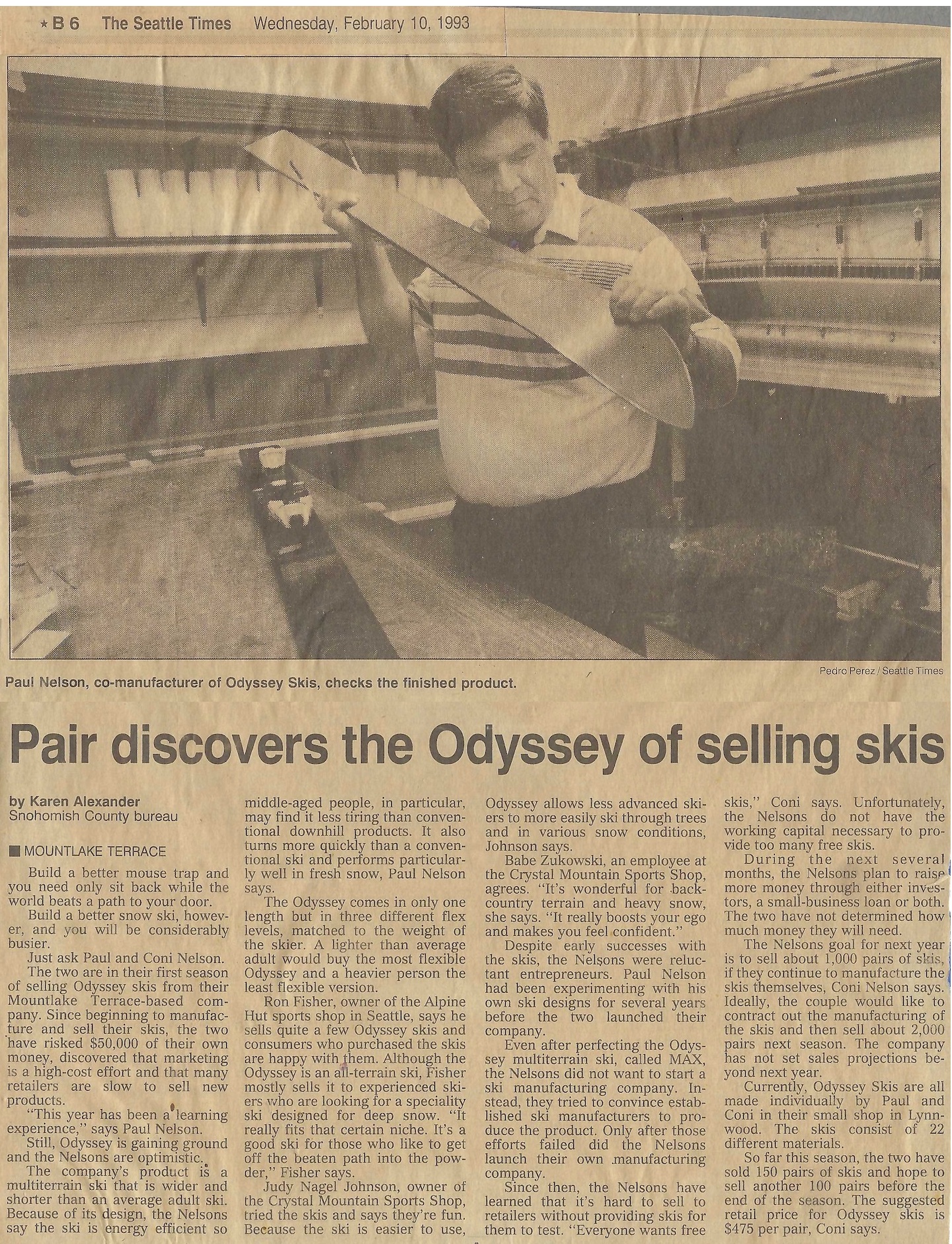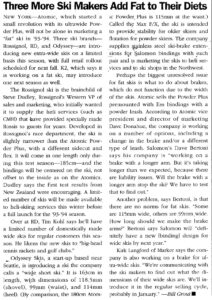The Great American Dream ???
Invent a new mousetrap… Patent It… Make Royalties… Live happily ever after… That sounds like something that we all dream of. It certainly was what I thought when I discovered my Wide Short Ski concept in 1991. An avid skier since my teens, then plagued with the debilitating disease of Chronic Fatigue Syndrome by the age of 20; I was motivated to search for an easier method to ski. I tried the shorter skis of the 70’s finding some benefit from them, but they fell short. I tried snowboarding and recognized the sidecut that gave the snowboard great turning ability, but not any energy savings for me. I designed several models of snow scooters, but I missed the performance and pleasure of skiing. I finally discovered that if I took the best of several products maybe just maybe it could make a significant difference. I made the ski wider for more flotation, shorter for maneuverability, and I put a sidecut in for easy turns. I was excited in 1991, with the first ski I handmade without a ski press( the red, white and gold in the picture, and #1 on the chart). The performance blew me away! I could envision a whole range of skis that could come by putting a sidecut in the ski. Skis for racing, skis for recreation, skis for powder, skis for parks. I was so certain of my idea, even without the resources to afford a patent attorney, I knew I had to file a patent.
I purchased a book called “Patent It Yourself” by patent attorney David Pressman . I read this book from cover to cover many times. I followed each and every step of the instructions in applying for my patent and for sharing it with others. I knew I had to document each step and that I couldn’t share my idea with anyone until I had filed for a patent. I did a thorough patent search to see if someone had previously discovered the same idea or something similar.
There were many ski patents, but no one had figured out this revolutionary concept. I researched everywhere I could to find prior art that related to my concept. It was non existent. I was told via patent attorneys that I paid for consulting, that the Patent Trademark Office doesn’t allow you to claim the broad area that I was attempting to claim in my original application. I was told to start my claims broad and then to reduce them in following responses, until I could define the maximum performance area of the invention.. So I did.. I wrote my original patent application which covered all the shaped skis that are currently on the market. If I could go back in time I of course would have had it drafted by a skilled patent attorney. I would have retained more of my original area. I did not have that choice at the time. After filing for my patent, I immediately sought out a manufacturer to assist me in this expensive journey ahead. K2 being a local company was the most logical to contact.

In September 1991, I presented K2 with three handmade prototypes (#2, #3, #4) to show different shaped options. (The red, white & gold, plus the two dark blue skis, called dragon wings) I also presented K2 with drawings for different design possibilities and marketing ideas. Although K2 signed a proprietary agreement and knew I had a patent application, they passed on the idea and told me to come back if I got a patent and they might reconsider. Their marketing department could not envision the concept selling but their engineering department was intrigued. I ask could they put their expertise into helping get this patent and hold the patent. They turned me away. (Currently all their models fall within the extended area the judge ruled on for this patent.)
I was desperate for financial and legal expertise so I continued my efforts to find a manufacturer that would engage in this odyssey with me. In 1991 and early 1992 eleven manufacturers returned proprietary agreements to view my shaped ski concept marketing package. While following through and talking with each of these manufacturers I was told that they were not interested in the shaped ski idea, and never once, when I asked, said they had prior art that would invalidate my patent pending.
From what I learned in the “Patent It Yourself” book, you must identify your best embodiment of the invention to prove your claims. I had a big job ahead of me. I was working on a shoe-string budget and needed to find investors or bring in cash in some manner. I decided to promote my invention and create a demand in the market place to help the industry pay attention and possibly come on board to finance this revolution I was so certain existed. I sent annual reminders to the manufacturers about the patent pending and the great possibilities the concept would provide.
I made every attempt to find resources to advance my endeavor. The banks were not interested in a business loan for an unknown with an unknown product. I had meetings with representatives from The Small Business Association. I believed in my dream. I was certain these skis would revolutionize the slowly declining ski industry, and help bring skiers back to the mountain. The concept could compete with the newly emerging snowboard market. I sold our home, I borrowed funds from family, taking these funds to enable my business venture and to support myself and family in this interim. This was a huge sacrifice for my family but I was certain it would pay off in the end. Had I proof that there was prior art that would affect my invention I would have walked away.
The next step in the journey – Make product, test skis and identify what dimensions would be the best for maximum efficiency for the invention. I had to get the ski manufactured. I could not find a ski company that would even make a ski for me. Finally, I convinced Connelly Waterskis, at the time commissioned to make K2 snowboards, to share their prototype technique. My training as a journeyman carpenter and tool maker for Boeing gave me the experience base to make my own press and molds and to design my own skis. Odyssey Skis was born. The journey continued.
In June of 1992, under proprietary agreements, I invited ski companies, ski magazine testers, and anyone I could locate, to come and test this new ski concept at Mt. Hood. This was experimental. Only two people showed up for that testing; Tim Kohl from Research Dynamics, and Seth Masia representing Ski Magazine.
Both guests tested the Odyssey MAX F/X skis (#7) in three different flexes with foams cores. Seth and Tim were extremely surprised and pleased. They couldn’t stop raving about the dynamics of the concept. This only fueled my fire. RD ask me if I would produce these skis for them. My price was too high for them. In January of 1993 Research Dynamics, even though they had signed an agreement with me, was marketing a version of my design calling it their idea. Yes indeed they liked it! They saw the future as well.
In April of 1993, once again under proprietary agreement, I trusted VOLANT with one of my newest prototypes for testing (#8), the MAX F/X II, 168cm, in hopes that they would help me get the patent and also manufacturer skis, because I did not intend to be a ski manufacturer. Volant met with me and showed interest while leading me to believe we would be doing business together. They were very interested and we spent much time in dialog. Suddenly the door was closed. I can only assume I was not a threat to them because VOLANT introduced their “brainchild” the CHUBB the very next season. The CHUBB had nearly identical dimensions as my prototype. ( #8) You know the one I had loaned them for evaluation. At that early date this was new concept on the market. By now I am finding that the ski industry was full of dishonorable people. Perhaps you could call them idea thieves. I was just a little inventor in their eyes without resources to be of any threat.
As time went by I continued to identify which range of shapes were going to be the most energy efficient. I made one ski in the middle of that range, the “Dragonsword” at 112 X 81X 105mm. (#11 ) Finally after 5.5 long years of debating with the PTO I was finally granted a patent on the Wide Short Ski design criteria in Feb. 1997.

Being a novice to patent law I thought six years of debate with the PTO to successfully argue the difference of my ski from other preceding patents, was a great success. I thought I would be given respect by the industry. I now had a patent to license or sell. I worked extremely hard over the next years contacting all manufacturers and personally negotiating some royalty agreements starting with K2 Corporation in 1997. Atomic, Salomon, Volant, Rossignol and Armada followed several years later. It wasn’t easy and there were many debates regarding area and prior art, and no one could produce valid prior art to successfully win the argument. If they had produced valid prior art I would have walked away and not spent my time or resources on this project. These companies signed agreements when they could not provide prior art. Royalty agreements to me VALIDATED my patent. I had finally arrived where the rainbow should be getting brighter. The ski companies weren’t making all the models that they are now. The All American Dream seemed to have possibilities…
Point of Interest Regarding K2 Ski Loan
I loaned K2 my Dragonsword (#11 ) in December of 1997 for evaluation. K2 had signed a royalty agreement with me prior. I was encouraging them to make this model of ski because of it’s superb performance. I knew it would be a very versatile ski for all skiers. The Dragonsword had the dimensions of the later highly acclaimed ski the K2 Public Enemy and then the K2 Fugitive, the K2 Shuksan, the K2 Piste Pipe, the K2 Axis XP, the K2 Apache Recon, and finally the K2 Instinct. My instinct was correct.
What happened to the dream?
K2, who was making the majority of the skis on the market, in my royalty bearing area, and were not paying me for most of their infringing skis. The industry was just starting to recognize the great beneficial dimensions of the patent. They were starting to make more and more skis directly in the royalty bearing area. But K2, Volkl owned by K2, and Line owned by K2, were the biggest infringers. The biggest infringers under contract with me, that were not honoring our royalty agreement.
I had an obligation to my other licensees that were honoring their agreement and paying their royalties, to enforce K2’s agreement. I had spent literally years of unsuccessful communications and attorney fees trying to enforce and negotiate a workable agreement with K2. K2 knew I did not have the resources to fight them. K2 has an in house legal team as well as a litigation firm that works full time on their behalf. Finally I was put in a position to cancel their agreement and bring suit against them for infringement of the patent. (Paul Nelson v K2) Yes, they were infringing. This should be easy to prove right?
I am sure you are saying, “Good for you. It is about time!!!”.
I was naive regarding the process that was in front of me. I found out that just because one has convinced the PTO of their invention, granted a patent, and successfully negotiated royalty agreements with manufacturers, doesn’t mean that you have a VALID PATENT.
I was mistaken.
The patent isn’t valid until you have successfully convinced a judge against a more skilled legal team that your patent has met all the legal benchmarks. Then and only then, can you have your day in court with a judge and jury to prove infringement. This gets even harder. To successfully enforce a patent against infringement one must go through a three phase process with the Federal Court before one can even litigate an infringement case to the court. This can cost several hundred thousand dollars. Dollars I didn’t have. I could not afford high powered attorneys. I located a contingency attorney that I was led to believe felt I had a strong case , and that contingency attorneys would be motivated by the fact that they don’t get paid unless they win the case. At that point there were literally hundreds of thousands of skis K2 had infringing my patent. What more motivation should these attorneys need than a multi-million dollar case? I was mistaken again.
The first phase is defining the claim construction of a patent. What do your claims really cover??? A federal judge has to do a claim construction. The PTO has already approved the patent, but now a judge has to go through it with a fine tooth comb and legally decide it’s worth. It is called the Markman Hearing. My attorney had to argue my patent claims against K2’s legal team. I had written my patent claims and I was confident of their strength. For years I had been defending my patent with at least a 3% variance. K2 defined 0% variance. In this part of the process the judge awarded my patent an additional plus or minus 3% onto the literal description in the patent.
JUDGE RULING – 10/15/2008 (URL) (PDF)
This was a great award that would have given me thousands more skis for royalties from other licensees as well. K2 was of course very unhappy with that ruling.
The second phase is called a Partial Summary Judgement to define the effective date of the patent. I originally filed my patent in 1991, and I was told by several consulting patent attorneys, that 1991 was a valid patent date since the claim area of my granted Feb. 1997 patent was included in the claimed area of my original 1991 application. I had faced this argument previously while negotiating royalty agreement and felt it had been answered satisfactorily. There were a few areas in the drafting of my 1992 claims response to the PTO that left room for doubt and could have been worded more clearly. The problem was that the judge found K2’s arguments more compelling than the arguments made by my attorneys.
JUDGE RULING – 2/5/2009 (URL) (PDF)
Although I reduced my overall dimensions in my 1992 response, referenced my MAX F/X ski dimensions nine times in descriptions and drawings in my 1992 reply to the PTO, the judge ruled that was not enough description pointing to my 1994 application to validate the patent filing date of 1991. The judge declared 1994 as my patent date. This is a bad blow for me.
After this ruling I was put in a position that K2 could realistically have my patent INVALIDATED with the sales my own invention. A problem in patent law that is widely known and controversial. At this point, I decided to offer to walk away from the lawsuit. I knew that if K2 won the next stage of this process, my patent would be INVALIDATED. I could lose my current agreements with all my other licensees. This was a very difficult decision. I had been convinced through previous counsel that I should have been allowed me to retain my 1991 filing date. With technicalities of the law this advice was no longer valid. K2 rejected my offer to walk away and be the only ones not paying royalties on the patent, which would have given them the advantage over the other manufacturers They wanted to INVALIDATE the patent and cause financial grief for me. They wanted to WIN not settle. I was never allowed to communicate with K2 directly. My attorneys told me from the beginning of this case that K2 was angry at me. I was never told why they were angry, but it seems like maybe I should have been the angry one.
K2 filed for a Summary Judgement (third phase) to invalidate the patent using the ruling from the judge using a 1994 filing date. The law says you can not sell even one pair of skis commercially within one year previous of your filing date of patent, unless they were primarily for experimental purposes, or research. There is an experimental bar that has to be met for the courts to consider your sales experimental. Although I did in fact sell MAX F/X skis starting in Sept. 1992, I was very active promoting the research and development of the concept to the industry and in the midst of trying to develop and define the best mode of the invention for my patent arguments. In 1993 I asked the PTO to grant time to research my concept further and was granted this permission to do so. During this time I developed two more versions of the MAX F/X ski. (#8 & #9 ) I had produced the original MAX F/X with half a dozen different flexes and 20 different layups and 3 different cores. I presented this information to my attorneys. My attorneys told me they would present this information to the court in our response, but they did not. I never intended on being a ski manufacturer. I hoped by doing the developing that one of the major ski companies would find their way to finish my task. While the developing and experimental days continued, my wife Coni was very persistent at following up all our sales by getting input from the skiers so I could define the concept better. We had demo surveys and invoices and follow up for all our sales the first year. I provided this to my attorneys; once again they did not present this entirely or in the proper fashion to the court. They gave bits and pieces in their response. The court needed this information. The judge in his ruling said “had he been given a more colorful experimental argument phase of the case he may have ruled differently.” Unfortunately the judge ruled in K2’s favor for lack of enough argument from my attorneys.K2’s legal team succeeded in INVALIDATING my patent Feb. 5, 2009, with the first sales of my own ski.
What this means is that all my royalty agreements with all the other manufacturers are now NULL AND VOID.
My income from my invention has CEASED. The project that I spent 18 years working on has been taken away by K2 and our legal system.
Within 24 hours K2 added to my burden. They sued me for attorney fees stating that I had known from the beginning that my patent was invalid. Stating this was a frivolous lawsuit that I knew all along was not winnable. Fortunately, several months later the judge ruled against K2 stating I had every right to think my patent was valid and to try to enforce my patent to protect my other licensees.
As you can imagine by now I am pretty beat down. You probably wonder if there is anyway that I can appeal the judges decision to INVALIDATE the patent.
Yes I did. But this story gets uglier.
The Dream has become a living nightmare.
I consulted with a different attorney to find out what my rights and chances are on appeal. Now, more education for me. Although this new consultant could see my case had, I repeat had great possibilities, the judge hadn’t been given enough information to rule in our favor. We could not put additional arguments in an appeal. We could file a suit against our own attorneys for misrepresentation. To do that it would take thousands once again. Which I do not have. An appeal is not another chance like I thought it was. It is simply you giving the Appeals Court the very same information as the other judge got, and hope three new judges see things differently. My attorneys didn’t give all my arguments, or documents to prove my case. They didn’t put out the efforts necessary to win the case. They didn’t hardly argue but five minutes in oral arguments. They didn’t give the judge the information he needed to make a ruling on my behalf. So I am left with no option but to drop the appeal because I can not now introduce the necessary additional information to an Appeals Court.
That bummed me out. At the same time K2 filed to appeal the judges decision on the attorney fees. They decide to argue once again that I knew all along that my patent was invalid. The Federal Circuit Court of Appeals ruled against K2 in favor of Judge Lasniks ruling on Feb. 5, 2010. JUDGE RULING – 2/5/2010. I don’t know what else K2 can take from me or what can be their motivation but that is where it all stands.
The American Dream of invent a new mouse trap and collect royalties for life, to me has been a hard worked dream, using every ounce of energy, intellect and resources available to me and my family. The little guy very infrequently prevails over the Big Corporation. I had hoped to be one of the few that could prevail. My efforts have been above and beyond my wildest dreams and nightmares. The end result hasn’t been the pot of gold but the knowledge that I did something for the snow skiers in the world. I brought needed attention to the shaped ski concept which made skiing more accessible and F U N for many.
We would like to thank all of you that have given your support, encouragement and kind words through this journey. Without your pep talks, thank yous, and belief in the process, and purchase of our product, we would have found it hard to continue.
Best Regards,
Paul & Coni Nelson



